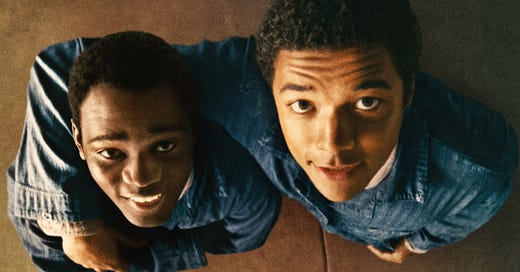Nickel Boys review - RaMell Ross's innovative style really brings a book to life
Empathy and cinema have always been inextricably intertwined, but RaMell Ross’s Nickel Boys, an adaptation of Colson Whitehead’s Pulitzer-Prize winning novel of the same name uses empathy as a lens to alter the fabric of the adaptation itself. Nickel boys follows Elwood, a Black boy who lives in 1960s southern USA with his Nana. The film opens with a sequence of experiences, using extreme close ups to show the little subtleties of life that often go amiss, things like showing knees in a bathtub give this form of observational gaze that is unique to the film and as it goes on this style becomes more and more apparent.
In this community, racial injustice looms large, we overhear conversations of what is happening on Selma, whilst Martin Luther King Jr is giving a speech on the TV in a shop window. Elwood’s Nana keeps a knife on her bedside. We are not involved in these moments, taking an almost naïve and youthful look, a bubbling undercurrent that you can’t quite form a clear picture but given enough to understand, it is like getting instructions from someone in a foreign language. Soon it is revealed that we are in Elwood’s point of view, literally stepping into his shoes as he enters into a world of extreme challenge and uproar, one where he is of immediate disadvantage.
The film shows Elwood as an inquisitive and thoughtful boy. However, one day he innocently gets a lift from someone in what we are told is a stolen car and the next thing we know Elwood is driving in the back of a police car on the way to Nickel Academy, a reform school which views its new attendees as grub, demanding that in order to leave they must conform, fit in with the harsh, corrupt and abusive practice particularly to the Black members of the institution.
The film has a completely unique style, with its use of extreme close ups and shallow focus giving an immediate intimacy to the characters, giving the sort of connection that cannot be made by words or actions but through the creativeness of film form. The score sounds natural and seeps into the background, evoking the feeling of discovering life. With a 4:3 aspect ratio and the use of point-of-view perspective it gives a totally unique and augmented experience unlike any other, it is confined and singular, with the gaze playing a vital role as characters stare down the barrel of the camera in what can be uncomfortable at times.
Nickel Boys is a film about stepping into someone’s shoes. It is wholly about empathy and understanding. To see life through someone else’s eyes and create a connection with an experience that you have not been through. Its totally unique style will be disconcerting for some, but if you get accustomed to the jarring nature of the picture, with dialogue coming off screen, it is one that will give an enormous amount of compassion.
One of the most jarring things about the film is that we cannot read Elwood’s facial expressions but rather we have to rely on the reactions of others in order to gain a fuller picture. However, later on this perspective does change to another character in order to show Elwood’s face and how he emotes. The shallow depth of field throughout gives the film a novelistic style, taking in little details which would be recorded in a book but cannot often be put to screen due to the stylistic differences between the mediums. However, director, RaMell Ross’s style is perhaps notably the strongest in creating the feeling of reading a novel and this may become the new adaptation style.
The film uses the point of view style to show reactions rather than the expressions of talking, with a thesis statement that suggests the reaction is the more interesting, telling and powerful image. In one particularly nasty moment of anguish, you hear physical abuse but can’t see it, as the tension builds and builds knowing what is going to happen down the line.
The leader of Nickel Academy is physically, verbally and mentally abusive, using them as slaves by telling them conforming is the only way of escape. It shows the characters painting grand houses with rebel green paint, poking to gain a reaction. Whilst they are shut down from dreaming, told that they were put on the Earth to sweep streets. Their education, to read Pride and Prejudice, even though the idea of courtship feels like an irrelevant idea from another planet.
The film is a deeply moving journey, helped with a terrifically absorbing score. It does a good job of juxtaposing the life of the oppressed characters of Nickel with the might of America with coverage of the Apollo 8 mission interjecting scenes of racial prejudice. It is hard to believe these events involve the same country. Whilst this tale of revolt or conform is a slow burn, that at times meanders through the friendship between Elwood and Turner, it is nevertheless and endearing and engrossing picture.
Nickel Boys is one of the most stylish and powerful films of the year. Whilst it is not the easiest watch and is a particularly slow paced which was a bit of a struggle, it was a truly captivating way to shoot this adaptation that packs a powerful punch throughout.





